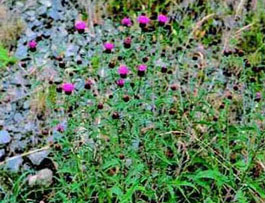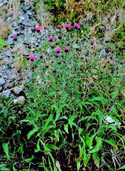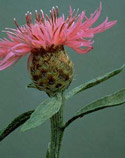|
Description: |
Meadow knapweed is a perennial plant with multiple upright, reddish stems growing 20 to 40” tall.
Leaves are about 6 inches long and 1 1/2 inches wide and decrease in size up the stem.
Its round flowerheads are mostly pink or purple, but occasionally white, and grow at the ends of branches approximately 3/4” in diameter. Knapweed flowers have distinctive papery looking bracts at their base that are rounded, or dark and fringed, but usually have both characteristics.
Seedlings are tap-rooted, mature plants develop a cluster of roots below the crown.
|
|
Why Is it a Noxious Weed? |
Meadow knapweed aggressively outcompetes other desirable plants as well as native species. It invades pastures, hayfields, meadows, riparian areas, forest margins, and rights-of-way. Infestations result in reduced forage, wildlife habitat, and species diversity.
|
|
Where Does it Grow? |
Meadow Knapweed invades moist sites like irrigated pastures, moist meadows, and along rivers, streams and ditches.
|
|
Control Options: |
-
As always, the best knapweed control is prevention. Above all else, prevent plants from going to seed.
-
Small plants can be pulled or dug up, especially in loose or sandy soil. Large plants with woody root crowns are more difficult to dig out. Be sure to bag up and remove all plant material to prevent the plant from re-establishing.
-
Spot spraying with an herbicide containing the active ingredient glyphosate (Roundup Pro, Glyfos, etc.) may be used effectively while the plant is actively growing, repeat as needed. For most effective treatments, apply before plants bloom and produce seed. Be aware, glyphosate is non-selective and will injure any plants that it comes in contact with, including grass.
-
For selective control of knapweed in agricultural settings (pastures, hayfields, etc.): an herbicide containing the active ingredient aminopyralid (example: Milestone, Milestone VM, etc.) may be applied anytime the plant is actively growing. Applications of aminopyralid are also effective in the fall before a killing frost. Aminopyralid products will not harm grass and can be used around livestock (provided all label precautions are followed).
-
When using herbicides, read and follow all label instructions and obey all label precautions. (Note: pesticide product registration is renewed annually and product names and formulations may vary from year to year.)
-
To minimize any harmful impact on bees and other pollinators, timing is important. Ideally, treat plants before blooming. If treatment after blooming is necessary, do control work early in the morning, or in the evening when bees are less active.
-
Some biocontrol agents have been shown to attack meadow knapweed, but do not control it. However, they have been shown to reduce the weed population somewhat. For information about the biological control of this or any other noxious weed, see the WSU Extension Integrated Weed Control Project .. .
|
|
More Information: |
Download our Flyer or visit Washington State Noxious Weed Control Board Here
|
|
More Pictures: |
|



